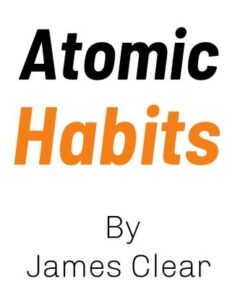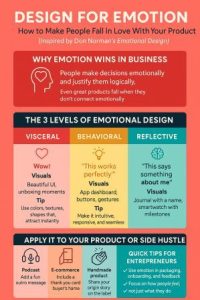Emotional Design Summary
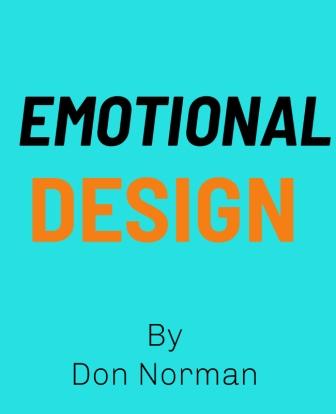
People don’t just use things—they tell stories with them. Your product is part of someone's identity. Design for meaning, not just function.
Emotional Design Summary
Ever wondered why some products just “click” with you—and others, no matter how well they work, leave you cold?
You’re not alone. We’ve all bought something just because it looked good, or held onto an old gadget because it meant something to us.
That’s emotion at work—and it’s exactly what Emotional Design by Don Norman is all about.
This book doesn’t just teach design—it helps you understand why people fall in love with products, and how you can create things that feel good, work well, and stay meaningful over time.
If you’re building anything for others—whether it’s a product, a service, or an experience—you need this book. It’ll make your work unforgettable.
Let’s dive into the Emotional Design summary.
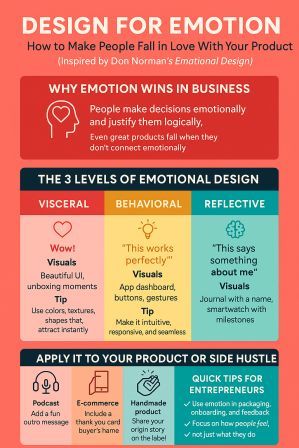
Why We Recommend this Book
Emotional Design has had a lasting impact across design, technology, and human-centred innovation.
Apple’s focus on beautiful form + smooth behaviour + brand identity reflects Norman’s principles.
IDEO’s human-centered design philosophy echoes his emphasis on emotion and empathy.
Norman’s ideas are part of design courses at Stanford (design school), MIT, and top design bootcamps. Norman’s work continues to influence how future designers are trained.
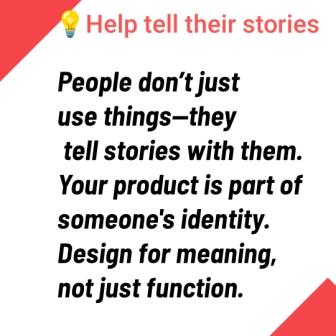
Questions to Ask Yourself before Reading Emotional Design
- Do I understand how emotion affects the way people interact with products, services, or spaces?
- Have I ever felt attached to an object—not because it worked perfectly, but because it made me feel something?
- When I design or create things, do I consider how it will make people feel beyond just solving a problem?
Why this matters: The book encourages designing not just for usability, but also for joy, comfort, and identity. - Do I know the difference between making something useful and making it meaningful?
- Am I open to rethinking my current design values—especially if I focus mostly on logic, performance, or aesthetics?
- What emotional experiences do I want people to have when they use something I’ve created?
Emotional Design
Introduction
In Emotional Design, Don Norman—renowned usability expert and bestselling author—shows us that great design goes far beyond function. It taps into emotion.
The kind that makes people smile when they unbox your product, trust it when it fails, and hold onto it long after it’s outdated.
This book breaks emotional design down into three powerful levels:
- Visceral – the instant, gut reaction
- Behavioural – the experience while using it
- Reflective – the meaning it holds over time
In this Emotional Design book summary, you’ll get the core ideas and real-life examples—like why we love cute robots, keep ugly mugs, and forgive our favourite gadgets for their flaws.
This summary gives you the map. The full book? That’s the full adventure.
If you’re building anything for people—apps, brands, products, even experiences—this book is a must-have.
It will change the way you design, and more importantly, the way people remember what you’ve made.
Ready to dive deeper? You’ll want to grab the full book after this.

Click on the Tabs Below to Read Emotional Design Summary
Emotional Design by Don Norman shows that the most successful and beloved products don’t just work well—they also make us feel good, by appealing to our emotions at three levels: visceral (appearance), behavioural (usability), and reflective (personal meaning).
Who Should Read Emotional Design?
Product Designers & UX Professionals
Why: It teaches you how to go beyond functionality and usability to create products people love, not just use—by designing with emotion in mind.
Entrepreneurs & Startup Founders
Why: If you’re building something new, this book helps you design experiences that create emotional connections—turning users into loyal fans.
Marketers & Brand Strategists
Why: It reveals how emotional design influences perception, memory, and attachment, giving you insight into how to craft more meaningful brand experiences.
Developers & Engineers
Why: It helps technical creators understand why aesthetics and emotional feedback matter, making your products more user-friendly and satisfying.
Educators & Content Creators
Why: It shows how to design learning experiences that are more engaging, delightful, and emotionally resonant—not just informative.
Chapter 1: Attractive Things Work Better
You know how sometimes you pick a tool, gadget, or app just because it looks nice—even if you don’t know how well it works yet?
In this chapter, Don Norman says: That’s not just shallow. It’s smart. According to Norman, “Attractive things work better.”
At first, that sounds like he’s talking about beauty over brains. But he’s not. He’s actually saying that when something looks good, we feel good—and that makes us use it better.
The Science Behind It
Norman backs this up with research. He talks about a study done in Japan. Researchers tested two versions of the same ATM interface:
- One was plain and boring.
- The other had nicer graphics and layout.
Functionally, they were identical. But guess what?
People said the “beautiful” one was easier to use.
Why? Because it made them feel relaxed and happy, and that emotional state made it easier for them to figure things out—even when both ATMs were the same!
Norman calls this the positive affect—when you’re in a good mood, your brain opens up. You’re more creative, more patient, and better at solving problems.
Example: Ever Played a Game You Loved for the Look?
Think about when you downloaded a mobile game just because the colours or characters are cute. Even if it’s tricky, you keep playing because it feels good. That emotional attraction motivates you to keep trying. If it were ugly, you might give up faster.
It’s the same reason you’ll forgive your stylish coffee machine for being a little hard to clean… but you’ll curse an ugly one that’s just as finicky.
Emotions Influence Us More Than We Realize
Norman isn’t saying function doesn’t matter. But he is saying that our emotional state changes how we experience a product.
If we’re stressed, even simple things feel harder. If we’re calm and happy (like when we’re using something beautiful), we’re more likely to find workarounds or keep trying.
Ever noticed how you’re more likely to enjoy using an app that has smooth animations and nice colours? That’s visceral design at work—your gut reaction to beauty affects your behaviour.
Example : The Teapots
Norman uses teapots to explain this.
One of them—called the “Nanna teapot”—was designed by architect Michael Graves. It’s sleek, elegant, and totally impractical. You can’t even pour from it easily. But people love it! They buy it, display it, talk about it.
Why? Because it makes them feel good just by looking at it. That’s emotional design. It might not “work” in the traditional sense, but it works emotionally.
Why This Matters for Design
Designers often obsess over functionality: “Does it do the job?” But Norman says that’s only one part of the experience.
If it doesn’t make people feel good, comfortable, or even excited—they won’t want to use it for long.
So the takeaway is:
- Good design is usable.
- Great design makes you feel something while using it.
Don Norman ends this chapter by reminding us that
design isn’t just logic. It’s also emotion.
And if you ignore how people feel, you’re only solving half the problem.
Chapter 2: The Multiple Faces of Emotion and Design
In chapter 1 Don Norman showed us that how we feel affects how we use things. In this chapter, he takes that idea deeper.
What exactly are emotions? How do they work? And how do they connect to design?
Our emotions are not just “nice to have” feelings floating around. They are actually part of our survival system, and they help us make fast decisions—even about everyday objects.
Think of Your Brain as Having Two Modes:
- Automatic & Emotional (fast and instinctive)
- Reflective & Rational (slow and thoughtful)
Let’s say you see a really sharp knife.
Your emotional system kicks in and goes:
“Ouch, dangerous!”
It’s immediate, even before you think logically.
But if the knife has a beautiful wooden handle, smooth grip, and feels balanced in your hand, another emotion might kick in:
“Wow, this feels premium!”
And suddenly you’re thinking of cooking a nice meal with it—even though it’s still sharp and potentially dangerous.
That’s the emotional brain reacting—and it shapes your entire experience.
The 3 Types of Emotional Responses
Don Norman explains that emotions aren’t just random reactions. They fall into three categories—and these are super useful to understand if you’re designing anything, or just wondering why you like (or hate) certain things.They are:
1. Visceral Emotion – Instant Reaction
This is your gut feeling. It’s subconscious and based on appearance.
Example: You see a red sports car and instantly go “Wow!”
You don’t know how fast it is. You don’t know the brand. But your visceral brain is impressed.
Designers use this when they make sleek phones, shiny kitchen tools, or cute packaging.
2. Behavioural Emotion – How It Feels in Use
This is about how well it works and how much control you feel while using it.
Example: You drive a car and notice how smoothly it handles. You love how it responds when you hit the brakes or turn. That’s behavioural emotion.
If the experience is smooth, easy, and reliable, your emotional brain rewards you with satisfaction.
3. Reflective Emotion – Meaning and Pride
This is the part that reflects on your values, identity, and memories.
Example: You keep an old mug your grandmother gave you. It’s chipped. It’s ugly. But you love it. That’s reflective design. It represents something deeper.
Brands play here all the time. A luxury watch, a custom notebook, or a framed photo—they make you feel proud, connected, or nostalgic.
Why You Might Love a Flawed Product
Let’s say you use a quirky old camera. It’s bulky and slow, but you love it. Why?
- Visceral: It looks cool and retro.
- Behavioural: You enjoy the satisfying click when you take a photo.
- Reflective: It reminds you of being in high school, capturing memories.
That’s how deep emotional design goes—it taps into all three levels.
Example: A Video Game Console
Let’s say you bought a Nintendo Switch:
- Visceral: The design is sleek and colourful—it looks fun.
- Behavioural: It’s easy to play and the controls feel right.
- Reflective: It reminds you of playing Mario as a kid or gives you family bonding moments.
That’s why people stay loyal to certain brands—because their products connect emotionally on multiple levels.
Norman is basically telling us:
If you want people to love your product, don’t just make it functional—make it emotionally rich.
Designers, developers, even business owners—need to ask:
- Will this product delight at first glance?
- Will it feel good to use?
- Will it make the user feel proud or connected?
Good design isn’t just about solving problems. It’s about sparking emotions that make people enjoy the experience and want to come back.
We may not always remember what something did… but we remember how it made us feel.
That’s the power of emotion in design.
Chapter 3: Three Levels of Design: Visceral, Behavioural, and Reflective.
In the last chapter, Norman hinted at how emotions shape our reactions to things.
Now, this chapter, he fully unpacks his big framework:
Great design works on three levels: visceral, behavioural, and reflective.
These levels are always operating—in your brain—at the same time.
And if a product nails all three, it becomes something you love, use often, and even talk about to others.
Think of the Three Levels Like Layers of a Cake:
Each level adds to the full flavour of the experience.
1. Visceral Design – First Impressions & Instinct
This is your gut reaction—how something looks, feels, smells, or sounds the moment you encounter it. It’s subconscious and automatic.
Norman says:
It’s all about appearance, feel, and presentation—what your senses pick up before your brain fully kicks in.
Examples:
You walk into a bakery, smell fresh bread, and feel instantly happy—even if you weren’t hungry.
You pick a water bottle that just looks cool, even if others are cheaper.
Apple packaging: The box feels smooth, opens with that gentle whoosh, and makes you go “wow” before you even turn the phone on.
Important: This level doesn’t care if it works—it just wants to know if it feels and looks good right away.
2. Behavioural Design – Usability & Function
This is your experience during use.
Does it feel easy? Smooth? Annoying? Awkward?
Norman says this is the level where true joy comes from function. It’s where the product does what it says—and does it well.
Examples:
- You love a chair not because it’s beautiful but because it supports your back perfectly.
- A microwave that’s intuitive—you don’t have to read a manual to figure it out.
- The feeling of a pen that glides smoothly across paper.
You’re judging how much control, confidence, and satisfaction you have while using the product.
Norman’s point is, people will forgive flaws in function if the product looks good (visceral), but they won’t keep using it unless it also works well (behavioural).
3. Reflective Design – Meaning, Identity & Story
This is the highest level—the thoughtful, memory-making, story-driven part of your brain.
It’s where we form attachments, pride, values, and meaning.
Reflective design makes you ask:
- Does this product say something about who I am?
- Does it remind me of something important?
- Do I feel proud owning this?
Examples:
- You keep your dad’s old, rusty watch—not because it works well, but because of what it represents.
- You buy a designer handbag not because it’s more practical, but because it says “I’ve made it.”
- You support a sustainable product brand because it aligns with your values.
Norman says reflective design shapes your long-term relationship with a product or brand.
It influences what you tell others, what you display, and what you remember years later.
Here’s How All 3 Work Together
Let’s say you buy a high-end coffee machine:
Visceral: It’s gorgeous. Shiny. Modern. You love just looking at it.
Behavioural: It’s intuitive. Makes perfect lattes. Easy to clean.
Reflective: It makes you feel like a sophisticated host. You enjoy showing it off.
Now you don’t just like the machine—you love it. It becomes part of your identity and daily ritual.
That’s what emotional design done right looks like.
Design Fails When You Miss a Level
Norman gives examples of when design fails:
- A beautiful product that’s frustrating to use → loses its charm fast.
- A useful product that’s ugly or embarrassing → gets hidden or avoided.
- A smart product that lacks personal meaning → doesn’t build loyalty.
So the best products:
- Catch your eye
- Work like magic
- Make you proud
Design is about emotion. Great design appeals to the eye, works beautifully in action, and becomes part of your life story.
If you’re a designer, entrepreneur, or even just a consumer—you can use this 3-level lens to understand why you love (or hate) certain things.
CHAPTER 4: FUN AND GAMES
Main Idea:
Design isn’t just about solving problems. It’s also about creating joy, play, and pleasure.
In this chapter, Don Norman takes a break from “serious” design topics like functionality and emotion systems to focus on something designers often ignore: fun.
Why Should Design Be Fun?
Norman says, We don’t need fun to survive… but we crave it.
And here’s the best part, even tools, appliances, and professional systems can be designed to be enjoyable.
He says many designers get so caught up in solving practical problems that they forget people want pleasure. We don’t just use products to complete tasks—we use them to feel something.
Example: Video Games
Take video games. At first glance, they’re totally impractical.
You’re not cleaning the house or filing taxes—you’re jumping on mushrooms or building castles.
But games are a masterclass in:
- Engagement
- Emotional highs
- Challenge and reward
They pull you in because they’re designed to keep you playing, learning, failing, and trying again—all while having fun. Norman points out:
The design of games gives us clues on how to make even serious things more enjoyable.
So, what if your educational app or kitchen gadget could learn from game design?
Building “Fun” Into Everyday Things
Norman challenges the reader to ask:
- Why can’t a toaster be fun?
- Why can’t a medical device give positive feedback like a game?
- Why can’t a car dashboard be playful and light?
He argues that fun doesn’t mean silly—it means engaging, delightful, and satisfying.
It All Ties Back to Emotion
Remember the three levels of design from Chapter 3?
Here’s how fun fits in:
Visceral Level: Fun can be triggered by colours, sounds, animations, and surprises. Think of how satisfying it is when an app bounces or glows when you complete something.
Behavioural Level: Fun comes from interaction. Smooth transitions, rewarding feedback, or just the joy of watching something work perfectly—like a pen gliding smoothly.
Reflective Level: Fun also ties into meaning. We might play word games to feel smart. We build LEGO because it makes us feel creative and nostalgic. We post fun content because it reflects our personalities.
Examples
Tamagotchis & virtual pets: People took care of pixelated animals on a screen. Not because they had to, but because the interaction felt good.
Juicy interfaces in mobile apps: Some apps make even typing or deleting things feel fun through animation and sound.
Novelty items: Like quirky salt shakers or alarm clocks that run away when they ring. They work—but they also make you laugh.
These kinds of objects don’t just “do the job.”
They leave an emotional trace. You remember them. You talk about them. You feel better using them.
Fun Enhances Learning & Creativity
Norman also explains how fun improves focus and learning.
When you’re relaxed and engaged, your brain is in a state that’s more creative and open to solving problems.
That’s why kids learn through play—and why serious tools can benefit from playful elements.
Example: Think of Duolingo. It’s teaching you a language, but it’s fun. It gives you rewards, animations, silly reminders from the owl… and it works.
But Wait—Isn’t Fun Frivolous?
Norman says no. He warns that people often dismiss fun as being childish or unnecessary.
But in reality, fun can be functional.
A product that is fun:
- Encourages repeated use
- Builds loyalty
- Reduces frustration
- Increases learning and memory
- Fun, when done well, serves a purpose.
Pleasure can be a powerful tool in design.
Don Norman leaves us with this challenge:
Start seeing delight and joy as serious design goals—just as important as usability and functionality.
Design is not just about helping people “get the job done.” It’s also about how people feel while doing it.
People remember fun. They return to products that make them smile.
Whether it’s a toaster, a game, a website, or a form… a little bit of fun can make a big difference.
CHAPTER 5: PEOPLE, PLACES, AND THINGS
Main idea:
The things we love aren’t always the most beautiful or useful—they’re the ones that hold meaning, memories, and identity.
Why We Fall in Love with “Stuff”
Have you ever owned:
- A beat-up sweater you couldn’t throw away?
- An old phone that doesn’t work but you still keep?
- A childhood teddy bear or game console?
That’s what Norman is exploring here:
Why do people get emotionally attached to objects that have no practical use?
The answer? Because those objects are tied to:
- People we love
- Places we cherish
- Memories we treasure
Design Is Personal
Norman says we don’t just use products—we live with them.
They become part of:
- Our daily habits
- Our social status
- Our identity
And sometimes, a worn-out object tells more of a story than something brand new.
He reminds us that objects can serve a reflective purpose (one of the three levels of design).
We look at them and remember who we were, where we were, or who we were with.
Example: The Ugly, Beloved Stuffed Animal
He shares an example of a little girl’s stuffed toy—tattered, dirty, and falling apart. Any adult would say, “Throw it out!”
But to the child, it’s priceless. It goes everywhere with her. It’s her comfort, her friend, her history.
That’s reflective design at work. It’s not about looks or function. It’s about meaning.
Places Trigger Emotion Too
Norman says the same thing happens with places—homes, streets, schools.
Ever visited your childhood neighbourhood and suddenly felt overwhelmed? That’s reflective memory kicking in.
We attach emotion to environments, not just objects. That’s why people decorate, customize, and personalize their spaces. They’re designing emotional comfort zones.
People Make Objects Matter
Here’s a really interesting point Norman makes:
A lot of the emotional value we place on things comes from who gave them to us or who we shared them with.
A plain necklace is just a necklace—until it’s the one your mom gave you on your wedding day.
So when designers ignore emotional context, they’re missing the real reasons people hold on to products.
Example: Family Heirlooms
Norman talks about people keeping furniture or dishes that are old-fashioned, chipped, or totally impractical—just because they belonged to grandma.
Even if they don’t match your house, you keep them. Why? Because they carry a story.
Designers who understand this can create products that invite meaning—through personalization, memory triggers, or story-rich experiences.
What Designers Can Learn
Norman encourages designers to:
Stop thinking only in terms of “form and function.”
Start asking:
- How will this object become meaningful to someone?
- Will this design age well emotionally, not just physically?
This is important for things like:
- Keepsake boxes
- Journals
- Jewellery
- Gifts
- Products made to be handed down or remembered
Even everyday tools—if they’re designed with story or personalization in mind—can build emotional value over time.
Memory Is a Design Material
Norman is quietly redefining what “good design” is.
It’s not just sleek, simple, and smart.
It’s also capable of collecting memories.
He encourages us to design with the understanding that users will:
- Attach meaning to things
- Build emotional narratives around products
- Remember feelings long after they’ve forgotten features
People hold on to things not because of what they do—but because of what they represent.
If you want your product to be loved, not just used, you need to make space for personal stories. It’s not just about design—it’s about life.
This chapter is about how emotional design doesn’t stop at feelings like delight or fun—it also includes deep emotional connections, like love, nostalgia, comfort, and identity.
People connect emotionally to:
- Objects (like old phones, toys, gifts)
- Places (homes, streets, rooms)
- People (and the memories attached to things they gave us)
Good design acknowledges these attachments, and even helps create them.
CHAPTER 6: EMOTIONAL MACHINES
Main idea:
What if machines could feel? Or at least, act like they feel? Should they?
In this chapter, Norman explores a powerful, futuristic, and slightly controversial idea:
Machines can—and maybe should—have emotions
…or at least give the appearance of emotion to improve how humans interact with them.
Why Emotion Matters in Machines
Think about how we interact with technology every day—phones, voice assistants, smart cars, ATMs. These tools are getting more humanlike, and we expect more from them—not just in function, but also in social intelligence.
Norman argues:
When a machine responds in a social or emotional way, people find it more engaging, friendly, and easier to use.
Example: Talking to Your Car
Ever yelled at your car? Or thanked your GPS?
That’s human emotion talking to a machine—even though we know it’s not alive.
Norman says this is natural. Humans are wired to project emotion and personality onto anything that acts even slightly human.
So instead of resisting it, he suggests:
Why not design machines that play along?
Machines That “Act” Emotional
Norman gives examples of robots, toys, and systems that mimic emotion to improve interaction.
Sony’s AIBO Robot Dog
It responds to petting, plays with toys, and acts like it has moods.
People formed emotional bonds with it—even though it’s just code and metal.
Users described it like a real pet:
- “It greets me when I come home.”
- “It seemed sad when I ignored it.”
Was it really sad? No. But it was designed to act in a way that triggered human emotion.
Social Cues in Design
Norman explains that emotion isn’t just about smiles and frowns. Machines can show emotion by:
- Voice tone (like Siri sounding cheerful)
- Pauses and reactions (a robot that “hesitates” before answering)
- Body language (even simple movements like tilting or bowing)
These social cues make machines feel more human, which makes humans feel more comfortable.
Why This Works: Humans Are Emotionally Wired
From infancy, we respond to faces, voices, and gestures. We’re always reading people—even when “people” aren’t actually people.
Norman says:
“Give an object two eyes and a mouth, and we treat it like a person.”
This isn’t just cute—it’s powerful.
It means:
- We can connect more deeply with machines that “get us”
- We can reduce user frustration with emotional feedback
- We can build trust through social design
Emotional Machines in Practical Use
It’s not just toys. Norman says this approach could help with:
- Elder care robots – offering companionship or reminders in a kind voice.
- Educational tools – that encourage kids or react to mistakes gently.
- Service machines – like kiosks or customer service bots that show patience and friendliness.
If a machine smiles when it greets you, or calmly reassures you when there’s an error, you’re less likely to get angry or frustrated.
The Ethical Dilemma
Norman doesn’t ignore the risks.
He raises tough questions:
- If a machine pretends to care, is that manipulative?
- Can fake emotions still create real attachment?
- Will we get too emotionally dependent on robots?
He talks about people grieving over AIBO when it stopped working—as if they’d lost a pet.
So he reminds us:
- Emotion in machines is powerful. Use it with care.
Designers have a responsibility not to trick people—but to create genuine emotional value, even if the emotion is simulated.
Machines don’t need real emotion. They just need to understand and respond to ours.
If a machine can understand your emotional state and respond accordingly, it doesn’t have to feel anything—it just has to behave as if it cares.
That alone can make the experience smoother, friendlier, and more human.
Quick Takeaway:
People naturally treat machines like people—especially if they show even a little emotion.
Machines that mimic social cues—voice, timing, body language—are easier and more enjoyable to use.
Designing emotional machines can improve learning, reduce stress, and build trust.
But we also have to be careful: don’t cross the line into emotional manipulation.
CHAPTER 7: THE FUTURE OF ROBOTS
Main idea:
Robots are becoming more emotionally intelligent — and that could change our relationships, our society, and even our sense of what it means to be human.
This chapter is where Don Norman goes full sci-fi… but with a thoughtful, real-world lens.
He asks:
“What happens when robots aren’t just tools—but companions, helpers, even friends?”
Robots as Part of Everyday Life?
Norman begins by saying that for many years, robots were just machines in factories. But now, we’re starting to invite them into our homes, schools, hospitals, and lives.
He paints a picture of a future where robots are:
- Helping the elderly
- Teaching children
- Comforting the lonely
- Acting as personal assistants
And they won’t just be efficient. They’ll be emotional—able to read your feelings and respond appropriately.
AIBO Strikes Again
He revisits Sony’s AIBO robot dog to show how people can form deep emotional connections with non-human things—as long as they act social, cute, or caring.
Owners:
- Gave AIBOs names
- Celebrated their “birthdays”
- Mourned them when they broke
Norman uses this to argue:
“If a robot gives off the right emotional signals, we treat it like it’s alive—even if it’s not.”
What Makes a Robot “Seem” Human?
Norman says it’s not about how realistic it looks. It’s about how believably it behaves.
Robots that:
- Pause before speaking
- Look at you while “listening”
- React to tone or mood
- Apologize when they “fail”
…tend to win people over.
Even if their faces are screens or they roll on wheels, if they behave in a human-like way, we’re naturally inclined to trust them.
Use Case: Robots for the Elderly
He explores how robots can be caregivers for ageing populations.
Imagine:
- A robot that reminds grandma to take her medicine
- One that keeps her company with conversation
- One that calls for help if she falls
This isn’t just helpful—it could reduce loneliness and extend independence. But it raises a deep question…
Are we okay with people forming emotional bonds with machines instead of humans?
Emotional Support or Emotional Substitution?
Norman doesn’t pretend there are no risks. He asks:
- Will kids grow up preferring robot friends?
- Will people get emotionally dependent on devices?
- Will we replace human care with cheaper robot alternatives?
He’s not saying this future is bad—he’s saying we need to be intentional and ethical in how we build and introduce emotional robots.
Can Robots Ever Truly Understand Emotion?
Short answer from Norman: Not really.
At least, not like we do.
But here’s the twist:
They don’t have to understand. They just have to act like they do.
And if they do it well—reading facial expressions, adjusting tone, remembering preferences—it can be just as effective.
The appearance of emotional understanding can still deliver a deeply comforting, helpful, and safe experience.
Robots don’t need to be people. But they should be emotionally smart.
Norman ends the chapter by saying we’re headed toward a world where emotionally responsive machines will be everywhere—from phones and toys to homes and hospitals.
He’s hopeful, but cautious:
- Use them to enhance human life.
- Don’t let them replace human connection.
Robots are moving from tools to companions and helpers.
If designed well, they can understand and respond to emotion, improving daily life.
But we must balance emotional benefits with ethical awareness—especially when robots are used with kids, the elderly, or the lonely.
Designers must take responsibility for the social and emotional impact of intelligent machines.
EPILOGUE: WE ARE ALL DESIGNERS
Main idea:
You don’t have to be a professional designer to design.
We all design—every single day—because design is about shaping the world around us to fit our lives, emotions, and needs.
Design Isn’t Just for Experts
Norman wraps up the book by turning to you, the reader.
He says:
Whether you’re arranging furniture in your living room, writing a shopping list, creating a lesson plan, or planning a birthday party—you’re designing.
Design is simply the act of making things better, more beautiful, more usable, or more meaningful.
So the question becomes:
- Are you doing it consciously or accidentally?
- Are you designing for joy or just for getting things done?
The Big Message:
Design With Emotion in Mind
Throughout the book, Norman has shown that design isn’t just about function or style—it’s about how people feel when they interact with something.
So in the epilogue, he says:
Take responsibility for the experiences you help create—big or small.
Even if you’re not a product designer or engineer, you:
- Design conversations with friends
- Design spaces at home or work
- Design routines for your life
So ask yourself:
- Does this setup feel good?
- Is this interaction pleasant?
Will this choice make someone smile, relax, or feel seen?
Everyone Can Learn to Design Better
Norman encourages us to think like emotional designers.
That means:
- Understanding what people feel
- Noticing how design affects mood and memory
- Being intentional about joy, beauty, and ease
He believes better design happens when we listen more and observe closely—when we design for real humans, not just “users.”
Design Is Human
He ends on an empowering note:
“We are all designers. Let’s embrace it.”
You might not sketch wireframes or build robots, but you shape experiences—at home, at work, in your community.
The question isn’t if you’re a designer. It’s what kind of designer you choose to be.
Quick Takeaway:
- Everyone is a designer—not just professionals.
- Design is about making life work better—and feel better.
- We shape the emotional tone of our world through small, everyday choices.
- We should design with empathy, emotion, and intention.
PERSONAL REFLECTIONS
Main idea:
“I didn’t always think emotions mattered in design—but I was wrong.”
Norman’s Design Evolution: From Logic to Emotion
Norman confesses something surprising:
He used to be obsessed with function, logic, and usability.
He believed if a product worked well and made sense, it was “well-designed.” Simple.
But over time, he noticed something odd:
- People loved products that weren’t technically perfect.
- Beautiful but flawed items sometimes won more affection than “smart” but boring ones.
- Emotions were powerful forces—even stronger than logic in some cases.
This observation challenged him to rethink what good design really meant.
So he started asking:
- “Why do people keep things that are broken?”
- “Why do they fall in love with awkward or inefficient tools?”
- “Why do we yell at computers and talk to cars?”
The answer? Emotion.
“I Was Wrong”
Norman openly admits:
“I was wrong to leave emotion out of the design equation.”
This is powerful because it shows how even experts can grow. He went from being a rational usability expert to a human-centered, emotionally-aware designer.
He now believes that good design isn’t just about:
- Solving a problem
…it’s about - Creating pleasure,
- Building trust,
- Triggering joy or nostalgia, and
- Honouring the human experience.
Stories from His Life
Norman shares a few personal moments—like falling in love with products not because they were the best, but because they were:
- Beautiful
- Fun
- Memorable
- Emotionally rich
He also talks about the joy of design itself.
Even making a chair or designing a simple interface can feel like storytelling—if you do it with care.
A Message to Designers and Non-Designers
Norman isn’t just writing for professionals here. He’s speaking to:
- Makers
- Parents
- Teachers
- Entrepreneurs
- Students
- Anyone who shapes experiences
He says:
“The goal of design is to make people’s lives better—not just easier or more efficient—but better emotionally.”
That might mean:
- Giving someone a sense of control
- Making someone laugh
- Creating pride or comfort
- Offering delight during a tough day
Norman is still curious and learning—even after decades of design work.
He believes emotion is the future of good design.
He ends with deep gratitude: to readers, to designers, and to anyone who tries to make life more human.
Don Norman once believed usability was everything—now he knows emotion is equally vital.
He learned this by watching real people interact with real products—and by staying curious.
His message to you: whether you design tools, spaces, moments, or conversations, do it with empathy, emotion, and love.
1. Make First Impressions Viscerally Pleasing
People judge objects, products, and spaces immediately based on how they look, feel, or sound—even before using them.
How to Implement this:
Step 1: Choose one object, product, or personal space (e.g. your desk, homepage, business card) that you interact with daily.
Step 2: Evaluate its first impression (ask: “Does this spark delight or dread?”).
Step 3: Improve it by tweaking colour, texture, sound, lighting, or presentation.
- Use softer lighting
- Add natural materials (wood, plants)
- Improve packaging or visuals
Timeframe:
30–60 minutes per item. You can do this gradually over 1–2 weeks.
Potential Challenges:
Limited budget → Use free or low-cost improvements (de-cluttering, rearranging, repackaging).
Uncertainty about taste → Ask 2–3 friends or colleagues for first impression feedback.
Measurable Metrics:
- Number of areas/items visually refreshed
- 1–5 scale of “delight rating” before and after (self-assessed)
- Social reactions (“Wow, I like your workspace!”) as feedback
2. Design for Smooth, Intuitive Use (Behavioural Level)
Once people start using something, they judge it based on how smoothly it works. Friction or confusion causes emotional frustration.
How to Implement this:
Step 1: Choose one task you (or your customer) do frequently—e.g., booking a session, opening an app, on-boarding a user.
Step 2: Map out each step. Note points where people hesitate, get confused, or make errors.
Step 3: Remove one obstacle:
- Simplify a button label
- Reduce steps in a form
- Add a helpful tip or on-boarding message
Timeframe:
1–2 hours to audit and revise a task. 3–7 days to monitor and optimize.
Potential Challenges:
Not noticing friction points → Watch someone else use your product or process.
Over-complicating the fix → Use the principle: “One fix per task”.
Measurable Metrics:
- Time-on-task before vs. after
- User drop-off rate or error rate
- Self-assessed “ease of use” score (1–10)
3. Introduce a Fun or Playful Element
(Adds emotional delight)
Products and experiences are more memorable when they include fun, surprise, or delight—even in serious tasks.
How to Implement this:
Step 1: Identify one boring or routine interaction (e.g., confirmation messages, loading screens, checklists).
Step 2: Brainstorm how to make it more playful:
- Use humour (“You’re awesome! Your form is on its way
- Add micro-interactions or animations
- Add rewards or mini-milestones
Timeframe:
1–3 days to design, test, and deploy.
Potential Challenges:
Fear of seeming unprofessional → Keep tone aligned with your audience’s personality.
Overdoing it → Balance is key. Use fun with function.
Measurable Metrics:
- Clicks or engagement with the new playful element
- Feedback comments from users
- Emotional tone of reviews (track words like “fun,” “cool,” “love”)
4. Design for Reflective Meaning and Story
(Taps into identity and memory)
People value things that reflect their identity, memories, or values—even more than how useful or beautiful the product is.
How to Implement this:
Step 1: Identify a product, service, or personal brand you offer.
Step 2: Ask: What kind of identity or story does this help people express?
Step 3: Enhance this reflective value:
- Add space for personalization (names, memories, milestones)
- Tell your story behind the product
- Let customers share their stories (testimonials, photos, memories)
Timeframe:
3–5 days for creative brainstorming and small adjustments.
Potential Challenges:
Not knowing what your users value → Ask them directly through a short survey or call.
Trying to force sentiment → Let stories emerge naturally through authentic interactions.
Measurable Metrics:
- Increase in user-generated content (testimonials, reviews)
- Repeat purchase or retention rate
- Word frequency in feedback: “reminds me,” “meaningful,” “personal”
5. Prototype an Emotionally Intelligent Interaction
Emotionally intelligent products adapt to how users feel—not just what they do. You don’t need AI to start—you just need empathy.
How to Implement this:
Step 1: Pick one scenario where emotions run high (e.g., failed payment, login issues, delayed service).
Step 2: Identify the emotional state users are likely to feel.
Step 3: Redesign your interaction to respond with empathy:
- Use gentle, kind wording (“Oops! We hit a snag. Let’s fix it together.”)
- Offer help clearly
- Acknowledge their frustration with reassurance
Timeframe:
5–10 days to audit, redesign, and test emotionally intelligent flows.
Potential Challenges:
Tone mismatch → Test with users. Let them tell you how it makes them feel.
Too many edge cases → Start with just one emotional moment, then expand.
Measurable Metrics:
- Drop-off rate in stressful flows (e.g., checkout errors)
- Complaints vs. positive feedback post-change
- Customer satisfaction (CSAT) scores before and after
Keep an “Emotion Tracker” Journal for a Week
To become a better emotional designer, start by noticing your own emotional responses to objects, tools, and environments.
At the end of each day, jot down:
- One thing that frustrated you
- One thing that delighted you
- One object or interaction you’re emotionally attached to
This builds emotional awareness—and gives you design clues.
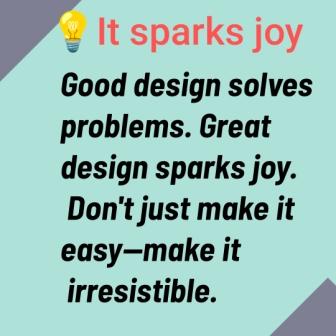
Don Norman is a globally respected expert in design, usability, and human-centered innovation.
With a background in both engineering and psychology, he has worked at the intersection of technology and human behaviour for over five decades.
He’s best known as the author of The Design of Everyday Things, and has held influential positions including:
Co-founder of the Nielsen Norman Group (a leading UX research firm)
Former Vice President of Advanced Technology at Apple
Professor Emeritus at UC San Diego
Norman is known for bridging the gap between academic theory and real-world application. His work has helped shape how designers and businesses think about products—not just in terms of how they work, but how they make us feel.
He’s a passionate advocate for designing with empathy and emotion, urging creators to prioritize human experience above all.
Book Details
Title: Emotional Design: Why We Love (or Hate) Everyday Things
Author: Don Norman
Publisher: Basic Books (a member of the Perseus Books Group)
Publication Date: January 15, 2004
Genre: Non-fiction, Psychology, Design, User Experience
Format Available: Paperback, Hardcover, eBook, Audiobook
ISBN: 978-0465051366 (Paperback edition)
Page Count Approx. 240 pages
Language: English
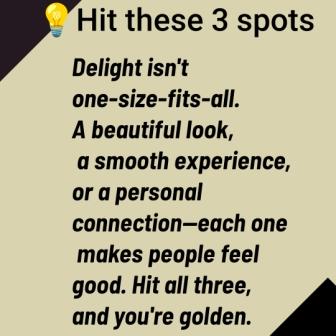
Emotional Design Quiz
-
Start Emotional Design Quiz
Your Next Read
